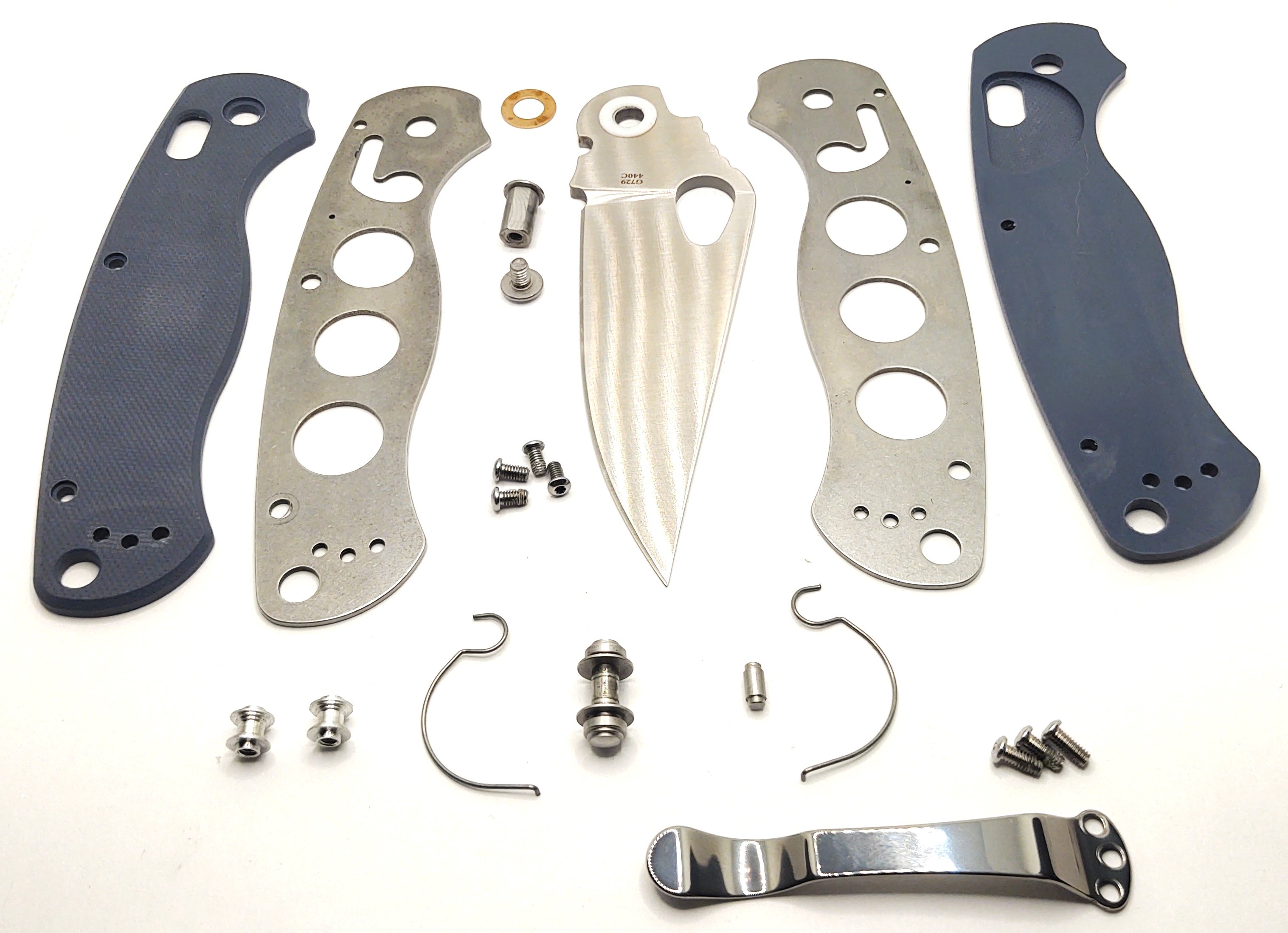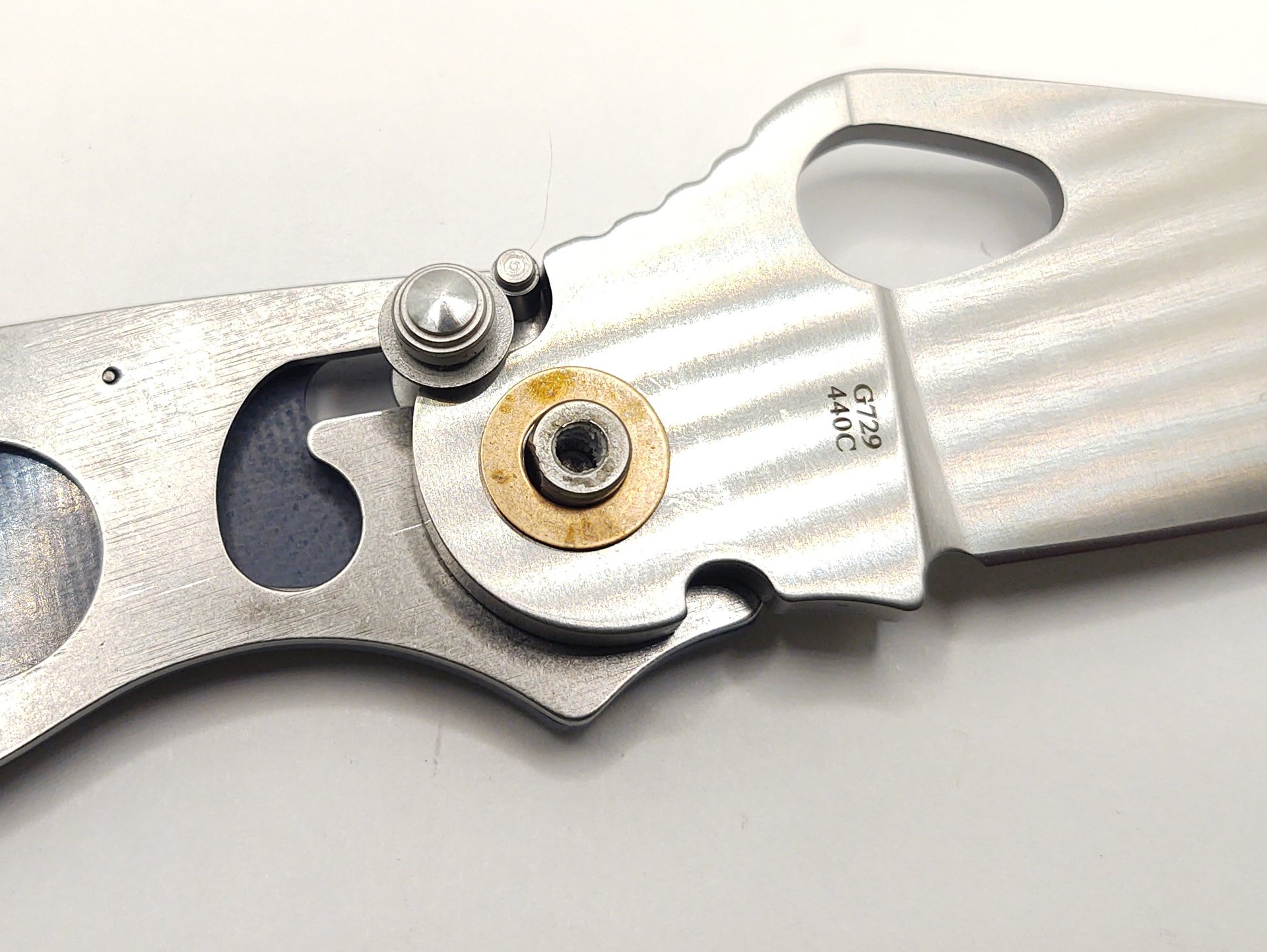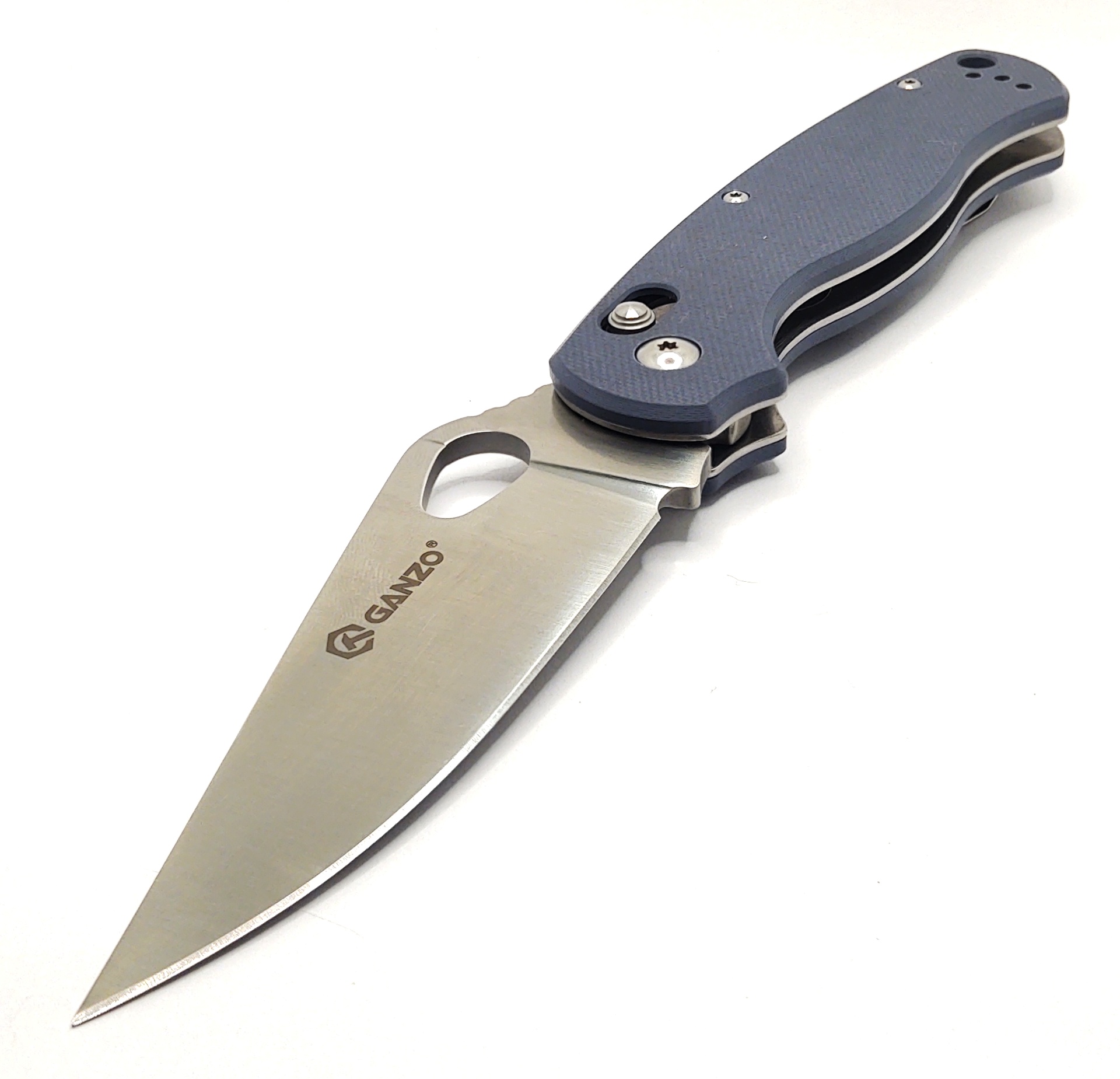Got your eye on the Spyderco Para Military 2, but haven’t got $200 burning a hole in your pocket? Or, do you like the Spyderco but really wish it had an Axis lock? Brother, have I got a deal for you.

This is a Ganzo G726 and, yes, it bears a rather striking similarity to a certain aforementioned knife. Doesn’t it just.
But it has a couple of key differences. The first is, yes, it’s got an Axis lock rather than Spyderco’s “Compression Lock.” (Which Ganzo calls their “G-Lock,” and have similarly equipped on many of their knives.)

The thumb opening hole is also teardrop shaped rather than round, presumably so Ganzo don’t wind up getting sued right into the dirt. And while the Para Military can have the clip reversed and swapped between tip up and tip down configurations, this knife has mounting holes for tip up only. It is still reversible, and with the ambidextrous opening method and lock this knife is thus suitable for left handed users. The clip is similar to, but uses a different hole pattern than, the Spyderco one. So alas, interchanging parts or installing custom scales and clips that fit the Spyderco will be impossible. Bummer.

And then, the blade is 440C rather than Spyderco’s CPM SPY27 custom crucible steel used in their current incarnations. It’s a shame that this is not one of their models that’s also available in D2. But we can probably excuse that, given that this model is only $22 at the time of writing.

And for $22 you get a lot of knife. As with the last Ganzo we looked at, despite coming from a Chinese manufacturer prone to, ahem, “borrowing” design elements from time to time and all the connotations that brings, the fit and finish of this knife is pretty much perfect.
This is 8-3/16" long when open with a 3-1/2" blade, 3-1/8" of which is usable edge. The blade has a full flat grind all the way to the spine which is very nice. The G729 is pretty broad, a full 1-5/8" across when closed at the widest point, which is the peak above the thumb opener hole. The blade is precisely 1/8" thick: 0.125". It’s 117.3 grams (4.14 ounces) altogether, with textured G-10 scales over steel liners. You can get this in a variety of colors but I chose this nice slate blue finish just to do something different for a change. The world knows I have quite enough boring black knives.
Suffice to say, this is a knife on the larger end of the EDC spectrum. It’s to be expected, considering it’s pretty much exactly the same size as the knife it’s mirroring.

The clip again apes the Spyderco one – mostly, at least, see above – and is not deep carry nor does it have any other fancy features. It’s not even engraved. But it’s got a good balance between spring tension and the grippiness against the scales. This knife draws easily from your pocket, but stays put confidently otherwise. That’s more than I can say even for a few more expensive knives from a manufacturer whose name starts with “B,” and ends in “enchmade,” and makes knives that bite onto your pocket’s seams like grim death.
The halves are separated with some nicely machined diabolo style spacers with little stairsteps in them. Swanky.

The G729’s pivot rides on one bronze washer and one nylon one, which is a little weird. These are visible just peeking through the gap, there. It works, though. The blade centering is good, but that’s easy to do when you cheat and use an Axis lock rather than a liner lock. With no mechanism inherently pushing the blade to one side, it remains resolutely square despite the mismatching washers.
I have to say, I really like the feel of the G729. That’s not to say, I like it “for the price.” I like it objectively, overall. The lockup is perfect, the action is nice, and the thumb hole feels good despite being a wonky shape. It opens and closes easily, smoothly, pleasantly, with no grind or drag or weirdness. There are no telltale signs of cheapness. Blade wiggle, none. No corners visibly cut, no details inexpertly executed. The spine of the blade feels nice. The subtly rounded jumping feels nice. The full flat grind helps make this an excellent cutter despite the broad blade and the edge geometry, at least on my example, is very good.

The lock mechanism and thumb hole opener bring to mind one other blue-grey knife from a particular manufacturer. The G729 (center) is longer, broader, but slightly thinner than the Griptilian (right): 0.518" across the scales and without the clip, whereas the Griptilian is 0.600". I think the textured G-10 scales ironically give you a better grip on it as well, and I like the full length steel liners of the Ganzo a lot more than Benchmade’s current fascination with making most of the knife out of plastic and only putting little metal plates at the end around the lock. The surface finish on the Griptilian’s blade is a lot nicer, but you’d fuckin’ well expect it to be for $138 more.
It’s bigger than the usual CQC-6K, also (left).
I don’t have a Para Military to compare it to. Actually, I only own two Spydercos at the moment and one of them is a balisong, and the other one is made out of wood. So sorry, I can’t help you there.
The G729 disassembles like you’d expect and looks like a typical Axis lock folder, mechanically speaking. Although the steel liners have speed holes in them presumably for lightness, which is pretty cool.

It’s easy to take apart in theory, but I did encounter a snag. The male side of the pivot screw was the singularly most gooped up with threadlocker screw I have ever encountered in my life. It’s ridiculous. Look at this:

An alarming amount of grunt was required to get it to let go. This was not helped by the wrinkle of having to guess which side is the male head and which side is the female, because the pivot screw is indeed D shaped and the female side will not spin freely in its hole. This is normally nice to see, but not when you’re applying 600 ft-lb of torque to a tiny T8 screw. Especially if it turns out to be the wrong T8 screw. But I did ultimately figure it out (it was the left side, the side with the clip on my example, for what it’s worth) and it let go without the head stripping. So the hardware is quality. But differentiating the screw heads would have been nice. Or, you know, not putting a Torx receptacle in the side you bloody well can’t turn.

There was so much threadlocker on that screw, in fact, that some of it that’d likely been spilled at the factory was also gluing one of the scales to one of the liners. This was easy enough to push free through one of the big holes in the liner. So there is your obligatory Chinese Knife Baffling Construction Detail identified and sorted out. It could have been worse.
Note also the dissimilar pivot washers.

Everything else inside is typical. The usual hair springs, the pair of spacers (which are aluminum), the lock crossbar, and the endstop pin.

The lockup. I went through the trouble to take this picture, so you’re going to see it. The blade has a fine as-machined surface finish on it which is very Spyderco-eque, and also causes it to go all striated under the LED’s in my photo light.
My example would “Axis flick” closed with the lock held back, but would not open that way in its out of the box state of tune. Backing the pivot screw out about 1/8 of a turn (after busting it loose…) solved this.

Oh yes.
The Inevitable Conclusion
Here it comes…
Ganzo has once again made a decent knife and made it available for not a lot of money. Now, you get to make your own decision on the ethics; how you feel about somebody coming along and undercutting another manufacturer on what’s pretty much their own design. I can’t make that determination for you. But really, my take on the matter is this isn’t really a knockoff of a Spyderco considering it’s actually mechanically different. But it’s definitely an alternative aimed at the same hypothetical buyer. Sure, Ganzo has copied Spyderco’s homework, but they’ve also copied Benchmade’s and put it in there as well, and changed the words around just a bit to keep the teacher from noticing.
The opposite point of contention here is that, overall excellent cutlery that they may be, the asking prices coming from some of the established major manufacturers – Spyderco, Benchmade, Zero Tolerance, Microtech, Tops and all – has really gotten out of hand in the last few years. And this is a point I’m probably going to be harping on a lot for a while going forward, so brace yourself. It seems like even in this hobby we can’t escape corporate greedflation. Prices rose during COVID; inflation, transportation, labor shortages, I get all those excuses from then. But now it’s now, it’s also becoming apparent that all these brands are intent on keeping their prices at that elevated level forever. One wonders how much extra profit is there to be gained, though, by pricing your products out of reach of a greater portion of potential buyers? A plain Bugout was $105 in 2019 and it’s $180 now. The Para Military was $140 in 2019 and it’s $190 now. And so on.
That’s not to say I don’t respect these manufacturers, especially for being the pioneers who invented the mechanisms and some of the designs we take for granted today. Those which paved the way for others to follow. Buying a Benchmade or a Spyderco supports American jobs, pays back the R&D, and nets you – historically, at least – some guarantee of quality. Look at this picture. Count them Benchmade boxes. I don’t think I, of all people, have taken a single morsel off of anyone’s table in Oregon City.

But the fact of the matter is, regardless everything, right now at this very moment we live in the best time there’s ever been for knife enthusiasts. Yes, prices on big premium brand name knives are high. But! These days there is a huge selection knives from all of these fresh faced makers like Ganzo, Civivi, CJRB whose products are frankly excellent. And not to mention that the selection and quality you can get from established budget brands like Kershaw, Boker, and CRKT is better than ever. I think nowadays it is no longer true to say that the “best” default answer is just to go out and buy a Spyderco or a Benchmade, because now there are so many options that are cheaper but damn near as or exactly as good.

Then there’s the steel question.
Is it nice to say that you have a knife made of the current crucible process wonder-steel, S30V or S35V or CPM-154 or VG-10 or CPM-20CV or CruWear or whatever? Sure, of course. But is it actually, in this day and age, necessary?
Well, no.
Look. I own, at current count, 107 knives. At least, the ones I am able to lay my hands on right now and are not squirreled away somewhere inconvenient. I just counted. And not counting the swords or the multitools. Premium ones, cheap ones, new ones, old ones. I like to think I have a pretty wide cross section to play with, and getting wider all the time.
I remember back when 440C was the king of pocketknife steels. Teenage me cut a lot of stuff with 440C with no problem. We were none the worse off for not knowing about future supersteels. 440C was what to look for back then – not 300 series, not 420, not 4116. Well, the properties of the stuff haven’t changed. Only our perceptions have.
Maybe CPM-20CV is “better” than 440C in some specific property as measured in a lab. But is it 8, 10, 12 times better for the price? Of course not. Fancy steels are not more expensive because they contain much different or better ingredients. The processes they use may be a little more precise, sure, but they’re mainly expensive because they’re produced in small amounts and the economies of scale aren’t there. But the “budget” steels are also produced with amazing consistency these days, and not to mention in great quantities. 440C wasn’t a budget steel in 1999. It is now only because mass manufacturing has it figured out. That doesn’t magically make it worse.
I also remember a time when a $22 knife would be guaranteed crap. So think on that one. All of this I say in defense of the Ganzo. Surely it’ll never be worth anything more than what it is. It’ll never be a collector’s item or an investment vehicle or sought after once it’s discontinued. That’s not the point of it.

I like the Ganzo G729. I like it despite where it came from and what it’s made out of. I think it’s a fantastic value for the money. And I will end on this, which is perhaps a dangerous thing to say: If you’re going to use it, and not just lock it in a drawer, I think it’s a better value for your money than its Spyderco twin.


D2/K110 doesn’t have the corrosion resistance I prefer (and 440C doesn’t do to well either as a barely stainless steel). A week in my work trouser pocket is enough to get rust specks on D2.